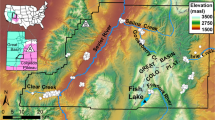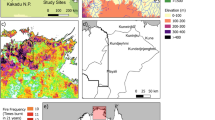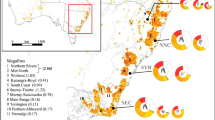Abstract
An increasingly accepted paradigm in conservation attributes valued modern ecological conditions to past human activities. Disturbances, including prescribed fire, are therefore used by land managers to impede forest development in many potentially wooded landscapes under the interpretation that openland habitats were created and sustained by human-set fire for millennia. We test this paradigm using palaeoenvironmental and archaeological data from New England. Despite the region’s dense population, anthropogenic impacts on the landscape before European contact were limited, and fire activity was independent of changes in human populations. Whereas human populations reached maxima during the Late Archaic (5,000–3,000 yr bp) and Middle–Late Woodland (1,500–500 yr bp) periods, lake-sediment charcoal records indicate elevated fire activity only during the dry early Holocene (10,000–8,000 yr bp) and after European colonization. Pollen data indicate closed forests from 8,000 yr bp to the onset of European deforestation, and archaeological evidence of pre-contact horticultural activity is sparse. Climate largely controlled fire severity in New England during the postglacial interval, and widespread openlands developed only after deforestation for European agriculture. Land managers seeking to emulate pre-contact conditions should de-emphasize human disturbance and focus on developing mature forests; those seeking to maintain openlands should apply the agricultural approaches that initiated them four centuries ago.
This is a preview of subscription content, access via your institution
Access options
Access Nature and 54 other Nature Portfolio journals
Get Nature+, our best-value online-access subscription
$29.99 / 30 days
cancel any time
Subscribe to this journal
Receive 12 digital issues and online access to articles
$119.00 per year
only $9.92 per issue
Buy this article
- Purchase on Springer Link
- Instant access to full article PDF
Prices may be subject to local taxes which are calculated during checkout




Similar content being viewed by others
Data availability
The data that support the findings of this study are available from the corresponding author upon request.
Change history
23 June 2020
A Correction to this paper has been published: https://doi.org/10.1038/s41893-020-0576-8
References
Kareiva, P., Watts, S., McDonald, R. & Boucher, T. Domesticated nature: shaping landscapes and ecosystems for human welfare. Science 316, 1866–1869 (2007).
Ellis, E. C. et al. Used planet: a global history. Proc. Natl Acad. Sci. USA 110, 7978–7985 (2013).
Ruddiman, W. F. The anthropogenic greenhouse era began thousands of years ago. Climatic Change 61, 261–293 (2003).
Kaplan, J. O. et al. Holocene carbon emissions as a result of anthropogenic land cover change. Holocene 21, 775–791 (2011).
Meggers, B. J. Amazonia: Man and Culture in a Counterfeit Paradise (Aldine-Atherton, 1971).
Denevan, W. The pristine myth: the landscape of the Americas in 1492. Ann. Assoc. Am. Geogr. 82, 369–385 (1992).
Clement, C. R. et al. The domestication of Amazonia before European conquest. Proc. R. Soc. B 282, 20150813 (2015).
Levis, C. et al. Persistent effects of pre-Columbian plant domestication on Amazonian forest composition. Science 355, 925–931 (2017).
Abrams, M. D. & Nowacki, G. J. Native Americans as active and passive promoters of mast and fruit trees in the eastern USA. Holocene 18, 1123–1137 (2008).
Askins, R. A. Restoring North America’s Birds: Lessons from Landscape Ecology (Yale Univ. Press, 2000).
Poschlod, P. & WallisDeVries, M. F. The historical and socioeconomic perspective of calcareous grasslands—lessons from the distant and recent past. Biol. Conserv. 104, 361–376 (2002).
Dunwiddie, P. W. & Caljouw, C. in Ecosystem Management: Rare Species and Significant Habitats (eds Mitchell, R. S. et al.) 271–275 (New York State Museum, 1990).
Valko, O. et al. Supporting biodiversity by prescribed burning in grasslands—a multi-taxa approach. Sci. Total Environ. 572, 1377–1384 (2016).
Dunwiddie, P. W. & Sferra, N. Loss of rare butterfly and plant species in coastal grasslands. Nat. Areas J. 11, 119–120 (1991).
Dengler, J., Janisova, M., Torok, P. & Wellstein, C. Biodiversity of Palaearctic grasslands: a synthesis. Agric. Ecosyst. Environ. 182, 1–14 (2014).
Mann, C. C. 1491: New Revelations of the Americas before Columbus (Knopf, 2005).
Marris, E. Rambunctious Garden: Saving Nature in a Post-wild World (Bloomsbury, 2011).
Pyne, S. J. Fire in America (Princeton Univ. Press, 1982).
Day, G. M. The Indian as an ecological factor in the northeastern forest. Ecology 34, 329–346 (1953).
Cronon, W. Changes in the Land: Indians, Colonists, and the Ecology of New England (Hill & Wang, 1983).
Poulos, H. Fire in the Northeast: learning from the past, planning for the future. J. Sustain. 34, 6–29 (2015).
Abrams, M. D. & Nowacki, G. J. Exploring the early Anthropocene burning hypothesis and climate-fire anomalies for the eastern U.S. J. Sustain. 34, 30–48 (2015).
Foster, D. R. & Motzkin, G. Interpreting and conserving the openland habitats of coastal New England: insights from landscape history. Ecol. Manage. 185, 127–150 (2002).
Foster, D. R. & Aber, J. D. Forests in Time: The Environmental Consequences of 1,000 Years of Change in New England (Yale Univ. Press, 2004).
Foster, D. R. A Meeting of Land and Sea: Nature and the Future of Martha’s Vineyard (Yale Univ. Press, 2017).
Dincauze, D. F. in The Pequots in Southern New England: The Fall and Rise of an American Indian Nation (eds Hauptman, L. M. & Wherry, J. D.) 19–32 (Univ. Oklahoma Press, 1990).
Patterson, W. A. III & Sassaman, K. E. in Holocene Human Ecology of Northeastern North America (ed. Nicholas, G. P.) 107–135 (Plenum, 1988).
Robertson, K. M., Poulos, H. M., Camp, A. E. & Tyrrell, M. Introduction to fire ecology in the Northeast: restoring native and cultural ecosystems. J. Sustain. 34, 1–5 (2015).
Sugita, S. Pollen representation of vegetation in Quaternary sediments: theory and method in patchy vegetation. J. Ecol. 82, 881–897 (1994).
Higuera, P. E., Peters, M. E., Brubaker, L. B. & Gavin, D. G. Understanding the origin and analysis of sediment charcoal records with a simulation model. Quat. Sci. Rev. 26, 1790–1809 (2007).
Thompson, J. R., Carpenter, D. N., Cogbill, C. & Foster, D. R. Four centuries of change in northeastern U.S. forests. PLoS ONE 8, e72540 (2013).
Foster, D. R. Thoreau’s country: a historical-ecological perspective to conservation in the New England landscape. J. Biogeogr. 29, 1537–1555 (2002).
Duranleau, D. L. Flexible Sedentism: The Subsistence and Settlement of Coastal New England and New York. PhD thesis, Harvard Univ. (2009).
Munoz, S. E., Gajewski, K. & Peros, M. C. Synchronous environmental and cultural change in the prehistory of the northeastern United States. Proc. Natl Acad. Sci. USA 107, 22008–22013 (2010).
Shuman, B. N. & Marsicek, J. P. The structure of Holocene climate change in mid-latitude North America. Quat. Sci. Rev. 141, 38–51 (2016).
Keeley, J. E. Fire intensity, fire severity and burn severity: a brief review and suggested usage. Int. J. Wildland Fire 18, 116–126 (2009).
Chilton, E. S. & Hardy, M. D. in The Cambridge World Prehistory (eds Renfrew, C. & Bahn, P.) 1293–1308 (Cambridge Univ. Press, 2014).
Oswald, W. W. et al. Subregional variability in the response of New England vegetation to postglacial climate change. J. Biogeogr. 45, 2375–2388 (2018).
Faison, E. K., Foster, D. R. & Oswald, W. W. Early Holocene openlands in southern New England. Ecology 87, 2537–2547 (2006).
Doucette, D. L. Unraveling Middle Archaic Expressions: A Multidisciplinary Approach towards Feature and Material Culture Recognition in Southeastern New England. PhD thesis, Harvard Univ. (2003).
Chilton, E. S. in Ancient Complexities: New Perspectives in Pre-Columbian North America (ed. Alt, S.) 96–103 (Univ. Utah Press, 2010).
Ritchie, W. A. The Archaeology of Martha’s Vineyard: A Framework for the Prehistory of Southern New England. A Study in Coastal Ecology and Adaptation (Natural History, 1969).
Doucette, D. L. & Herbster, H. Intensive Archaeological Survey of the Red Gate Farm-Lot 1 Project Area, Aquinnah, Massachusetts (Public Archaeology Laboratory, 2005).
Ledig, F. T. & Fryer, J. H. A pocket of variability in Pinus rigida. Evolution 26, 259–266 (1972).
Motzkin, G., Orwig, D. A. & Foster, D. R. Vegetation and disturbance history of a rare dwarf pitch pine community in western New England, USA. J. Biogeogr. 29, 1455–1467 (2002).
Sandplain Grassland Network (Woods Hole Research Center, 2019); http://sandplaingrassland.net
Foster, D. R., Motzkin, G., Bernardos, D. & Cardoza, J. Wildlife dynamics in the changing New England landscape. J. Biogeogr. 29, 1337–1357 (2002).
Wofsy, S. C. et al. Net exchange of CO2 in a mid-latitude forest. Science 260, 1314–1317 (1993).
Donahue, B. et al. A New England Food Vision (Univ. New Hampshire, 2014).
Reimer, P. J. et al. IntCal13 and Marine13 radiocarbon age calibration curves 0–50,000 years cal bp. Radiocarbon 55, 1869–1887 (2013).
Haslett, J. & Parnell, A. A simple monotone process with application to radiocarbon-dated depth chronologies. J. R. Stat. Soc. Ser. C 57, 399–418 (2008).
Fægri, K. & Iversen, J. Textbook of Pollen Analysis (John Wiley & Sons, 1989).
Whitlock, C. & Larsen, C. in Tracking Environmental Change Using Lake Sediments (eds Smol, J. P. et al.) 75–97 (Kluwer, 2001).
Daily Temperature Accumulations − 32 Base Temp (USA National Phenology Network, 2019); https://doi.org/10.5066/F7SN0723
Foster, D. & Gould, E. Forest Change and Human Populations in New England 1600–2006 (2009); https://go.nature.com/2T3wyw3
Acknowledgements
We thank D. Donnelly, E. Doughty, E. Faison, B. Hall, B. Hansen, K. Kirakosian, D. MacDonald, T. Parshall, M. Patel and E. Taylor for their contributions. D. Orwig, N. Pederson and S. Munoz provided constructive feedback. Data were provided by the USA National Phenology Network. This research was supported by National Science Foundation grant nos DBI‐0452254, DBI‐1003938, DBI‐1459519, DEB‐0620443, DEB‐0815036, DEB-0816731, DEB‐0952792, DEB‐1146207, DEB-1146286, DEB‐1146297 and DEB‐1237491.
Author information
Authors and Affiliations
Contributions
W.W.O., D.R.F., B.N.S., E.S.C., D.L.Doucette and D.L.Duranleau designed the project and participated in fieldwork, laboratory work and/or data analyses. W.W.O. and D.R.F. wrote the first version of the paper. W.W.O., D.R.F., B.N.S., E.S.C., D.L.Doucette and D.L.Duranleau contributed to the final version.
Corresponding author
Ethics declarations
Competing interests
The authors declare no competing interests.
Additional information
Publisher’s note Springer Nature remains neutral with regard to jurisdictional claims in published maps and institutional affiliations.
Supplementary information
Supplementary Information
Supplementary Tables 1 and 2.
Rights and permissions
About this article
Cite this article
Oswald, W.W., Foster, D.R., Shuman, B.N. et al. Conservation implications of limited Native American impacts in pre-contact New England. Nat Sustain 3, 241–246 (2020). https://doi.org/10.1038/s41893-019-0466-0
Received:
Accepted:
Published:
Issue Date:
DOI: https://doi.org/10.1038/s41893-019-0466-0
This article is cited by
-
Boreal forest cover was reduced in the mid-Holocene with warming and recurring wildfires
Communications Earth & Environment (2024)
-
Native American geography shaped historical fire frequency in forests of eighteenth-century Pennsylvania, USA
Scientific Reports (2023)
-
The Yale Geochronometric Laboratory and the Rewriting of Global Environmental History
Journal of the History of Biology (2023)
-
Pre-Columbian red pine (Pinus resinosa Ait.) fire regimes of north-central Pennsylvania, USA
Fire Ecology (2022)
-
Differences in forest composition following two periods of settlement by pre-Columbian Native Americans
Vegetation History and Archaeobotany (2022)



